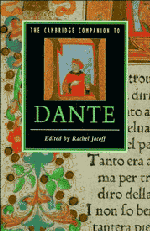Book contents
- Frontmatter
- 1 Life of Dante
- 2 Dante and the lyric past
- 3 Approaching the Vita nuova
- 4 The unfinished author
- 5 Dante and the empire
- 6 Dante and Florence
- 7 Dante and the classical poets
- 8 Dante and the Bible
- 9 The theology of Dante
- 10 A poetics of chaos and harmony
- 11 Introduction to Inferno
- 12 Introduction to Purgatorio
- 13 "Shadowy prefaces"
- 14 Dante and his commentators
- 15 Dante in English
- Further reading
- Index
2 - Dante and the lyric past
Published online by Cambridge University Press: 28 May 2006
- Frontmatter
- 1 Life of Dante
- 2 Dante and the lyric past
- 3 Approaching the Vita nuova
- 4 The unfinished author
- 5 Dante and the empire
- 6 Dante and Florence
- 7 Dante and the classical poets
- 8 Dante and the Bible
- 9 The theology of Dante
- 10 A poetics of chaos and harmony
- 11 Introduction to Inferno
- 12 Introduction to Purgatorio
- 13 "Shadowy prefaces"
- 14 Dante and his commentators
- 15 Dante in English
- Further reading
- Index
Summary
DANTE IS HEIR to a complex and lively Italian lyric tradition that had its roots in the Provençal poetry nourished by the rivalling courts of twelfth-century southern France. The conventions of troubadour love poetry - based on the notion of the lover's feudal service to “midons” (Italian “madonna”), his lady, from whom he expects a “guerdon” (Italian “guiderdone”), or reward - were successfully transplanted to the court of Frederick II in Palermo, which became the capital of the first group of Italian vernacular lyric poets, the so-called Sicilian School; the centralized imperial court did not offer a suitable venue for the transplantation of Provence's contentious political poetry, which was left behind. The “leader” (or “caposcuola”) of the Sicilian School was Giacomo da Lentini, most likely the inventor of the sonnet (while the Provençal canso was the model for the Italian canzone, the sonnet is an Italian, and specifically Sicilian, contribution to the various European lyric “genres”). Giacomo signs himself “the Notary,” referring to his position in the imperial government; this is the title Dante uses for him in Purgatorio 24, where the poet Bonagiunta is assigned the task of dividing the Italian lyric tradition between the old – represented by Giacomo, Guittone, and Bonagiunta himself – and the new: the avant-garde poets of the “dolce stil novo” or “sweet new style” (Purgatorio 24, 57), as Dante retrospectively baptizes the lyric movement that he helped spearhead in his youth.
- Type
- Chapter
- Information
- The Cambridge Companion to Dante , pp. 14 - 33Publisher: Cambridge University PressPrint publication year: 1993
- 3
- Cited by

